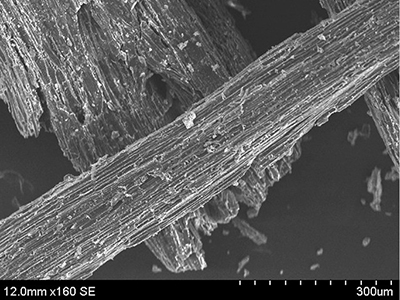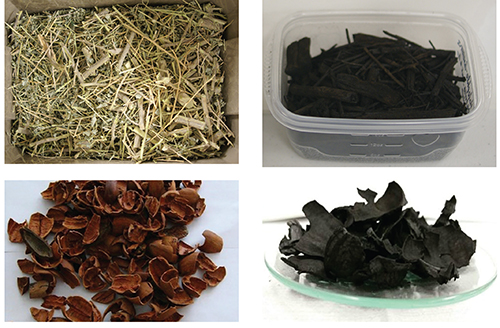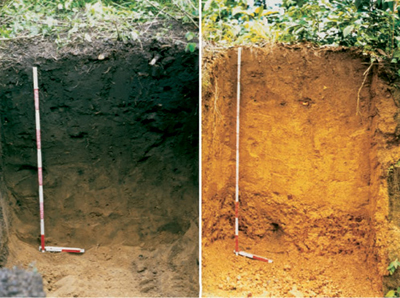Circular 690
John Idowu and Catherine E. Brewer
College of Agricultural, Consumer and Environmental Sciences, New Mexico State University.
Authors: Respectively, Extension Agronomist, Department of Extension Plant Sciences; and Assistant Professor, Department of Chemical Engineering, New Mexico State University. (Print friendly PDF)
What Is Biochar?
Biochar is black carbon or charcoal made from biomass—biological, organic materials derived from plants and animals. Biochar is created by heating biomass in an environment that has little or no oxygen (Figure 1), a process called pyrolysis. The net effect of pyrolysis is the production of a solid material (biochar) that has a high concentration of carbon and does not easily break down in the soil. By applying biochar to the soil, the soil’s carbon content can be increased significantly. This added carbon can persist in the soil for a very long time (carbon sequestration).

Figure 1. Surface texture of biochar made from big saltbush (Atriplex lentiformis) stems under a scanning electron microscope. (Photo credit: Sterling Ellis, NMSU.)
One could say that biochar is charcoal for soils. There are some important distinctions between biochar and other materials. Biochar is made from biomass of recent origin. This means that it is made from recent woody or plant waste materials (Figure 2). Some biochars are also made from animal wastes, such as manure and poultry litter. Biochar is not made from coal or coke, which is a carbon-rich product from petroleum refining. Biochar can be used as a soil amendment in that it can improve certain soil properties. Although it does contain some nutrients, biochar is not considered a fertilizer.

Figure 2. Biomass (left) and biochar (right) from big saltbush (top) and pecan (Carya illinoinensis) shells (bottom). (Photo credits: Catherine Brewer [top left], Kwabena Sarpong [top right], Jere Freeh [bottom left], and Jose Rodriguez [bottom right].)
History of Biochar
Biochar, and the idea of applying charred organic materials to soils, is not new (Lehmann and Joseph, 2015). Japanese horticulture has a tradition of applying wood chars to soils to improve plant growth. Agriculture and waste management manuscripts from Europe in the 19th century include charcoals in recommendations of potential “manures” for field applications (Wilson, 2013).
The modern study of biochar stems from investigations of terra preta, or anthropogenic (human-made) black earths. Terra preta has been found to cover large areas in numerous sites throughout the Amazon. Soils in this region of the tropics are generally weathered, high in acidity, and very poor, having almost no fertility besides a thin top layer of soil bolstered by recently decomposed plants. However, in areas occupied by indigenous people, there are very deep, dark, and fertile soils that remain productive year after year. Soil scientists investigating terra preta found the key difference between the fertile soils and the neighboring soils was the presence of charred materials. The charred materials were frequently found with pottery shards, fish bones, and other evidence of organic waste materials added by the people who lived in the Amazon, so we know that the char is not just from forest fires.
Terra preta has a very dark surface horizon that extends downwards and is comprised of the black carbon accumulated over thousands of years; the native soil profile, on the other hand, has light-brown colored soil (Figure 3). Measurements conducted on terra preta soils show three times more soil organic carbon than native soil and a better soil fertility as measured by cation exchange capacity and available phosphorus, nitrogen, calcium, and magnesium (WinklerPrins, 2014). Additionally, terra preta soils have a more neutral pH, better moisture retention, and higher microbial diversity compared to surrounding soils without additions of black carbon (WinklerPrins, 2014). Glaser and Birk (2012) provide a thorough summary of what is currently understood about terra preta.

Figure 3. Soil profile of terra preta (left) compared to the native soil profile (right) in the same region. (Source: Glaser et al., 2001; used with permission.)
Growers in New Mexico and other states have become interested in using biochar as soil amendments in order to replicate the beneficial effects observed in terra preta soils. Readily available technologies for producing biochar from plant material and animal waste have increased commercial production and availability of biochar products. With increased availability and interest, it is important that producers are well informed about what to expect when using biochar as a soil amendment.
Impacts of Biochar on Soils and How Different Soils Respond
Soil moisture and soil physical properties
One of the cited benefits of biochar presented in many studies is its effects on soil moisture retention. However, the impact of biochar for soil moisture improvement depends on the biomass feedstock, pyrolysis conditions, and soil type (Idowu et al., 2017; Novak et al., 2012; Woolf, 2008). Novak et al. (2012) tested biochar made from hardwood, peanut shells, pecan shells, poultry litter, and switchgrass on two different soils (sandy loam and silt loam). They found both soils had improved moisture retention due to biochar addition. They also discovered the switchgrass biochar produced at 500°C and added at 2% by soil weight gave the best moisture retention in the soils, which was about 10% more than soils without biochar. Other authors found an increased benefit in moisture retention due to the addition of biochar in sandy soils more than in clay soils (Woolf, 2008). Therefore, when applying biochar for soil moisture improvement, producers need to consider their soil type because not all biochars can improve moisture retention in all soil types.
Other soil physical properties shown to be positively impacted by biochar applications include soil bulk density (Zhang et al., 2012), soil aggregate stability (Idowu et al., 2017; Ouyang et al., 2013), and moisture flow within the soil (Herath et al., 2013; Ouyang et al., 2013).
Soil nutrients and soil chemical properties
Depending on biomass feedstock and pyrolysis conditions, biochar can add nutrients to soil and modify the soil’s chemical environment. Ultimately, biochar’s effect on soil fertility depends on the initial fertility of the soil; therefore, the effect of biochar on soil fertility or crop productivity may not be apparent in soils that are already fertile (Woolf, 2008).
Many studies show biochar can improve soil fertility by delivering important nutrients to the soil, such as nitrogen, phosphorus, potassium, and calcium (Idowu et al., 2017; Zhang et al., 2016; Atkinson et al., 2010; Novak et al., 2009). The amount of nutrients delivered to the soil, however, is highly dependent on the feedstock from which biochar is made (Atkinson et al., 2010). For example, wood biochars were shown to have lower total nitrogen, phosphorus, potassium, sulfur, calcium, and magnesium than manure-based biochars (Singh et al., 2010). Biochar made from animal wastes has been shown to contain significant amounts of nitrogen that led to improved crop yields compared to the control soil without biochar, and also improved nutrient use efficiency (Chan et al., 2008). Chan et al. (2008) found that combining poultry litter biochar with nitrogen fertilizer provided a better crop yield compared to nitrogen fertilizer alone.
In arid regions, caution must be exercised when using biochar since it can affect soil pH and salinity (Zhang et al., 2016). Generally, the pH of most arid soils is already in the high range, and raising the pH further can create management challenges for crop production and nutrient availability. Similarly, arid soils are prone to salt accumulation, and any practice increasing soil salinity should be avoided. Therefore, when using biochar as a soil amendment in arid soils it is important to know and account for the pH and salinity characteristics of the biochar being applied.
Soil microbial activity
Studies show biochar can promote soil microbial activity, leading to better nutrient cycling (Anderson et al., 2011; Lehmann et al., 2011). Specific observations indicate that biochar applications can increase soil microbial biomass, the number of soil microbes associated with nitrogen cycling, soil mycorrhizal association, and soil organisms associated with aggregate stabilization (Anderson et al., 2011; Liang et al., 2010; Warnock et al., 2007). There are several proposed explanations for why microbial biomass and activity increase with the addition of biochar, including i) adhesion of bacteria to biochar surfaces, which protects bacteria from being leached into the soil; ii) protection of soil microbes against grazing (predation) when they reside inside biochar pores; iii) sorption of harmful toxic compounds by biochar, thus preventing microbes from being harmed by these toxins; and iv) protection of soil microbes inside the biochar pores from desiccation when the soil dries out (Lehmann et al., 2011). In all likelihood, all of these processes work together to different extents in different soils to encourage increases in microbial quantities and activity in biochar-amended soils.
Another interesting observation from soil studies is the reduction in nitrous oxide (N2O) emission due to biochar addition (Cayuela et al., 2014; Kammann et al., 2012). Nitrous oxide is a powerful greenhouse gas approximately 300 times more potent than carbon dioxide. Emissions of N2O often take place in water-saturated, nitrogen-rich agricultural soils. The process of losing soil nitrogen as N2O is called denitrification. The exact mechanism by which biochar reduces N2O emission is not yet clear, but there are suggestions that the rate of biochar application, the amount of nitrogen in the soil, and the texture of the soil all interact to determine the extent of N2O emission reduction by biochar (Cayuela et al., 2014).
Effect of Biochar on Crop Productivity
Many studies have reported yield increases for different crops due to biochar application (Jeffery et al., 2011; Zhang et al., 2012). The impact of biochar on crop yields varies depending on the crop, type of biochar, and rate of application. Yield increases are generally attributed to increased phosphorus and nitrogen added to the soil through biochar. Therefore, for biochar to increase crop yields, the feedstock from which the biochar is made must have high levels of nutrients (Jeffery et al., 2017). It is important to know the initial fertility of the soil receiving biochar since the impacts of biochar on soil fertility and crop nutrition are more pronounced in low-fertility soils (Jeffery et al., 2017). It is vital to know the crop-available nutrient contents of the biochar, especially when used for crop production. Based on soil test results, fertilizer applications can be adjusted to credit the amount of nutrients delivered by the biochar. For more on soil testing, see NMSU Extension Guide A-114, Test Your Garden Soil (https://pubs.nmsu.edu/_a/A114.pdf).
How Much Biochar to Apply
There are no general prescribed rates for biochar applications. While some studies have used very high rates with success, other studies report reduced plant growth with high application rates (Kammann et al., 2011). A research gap exists on the optimal rate and frequency of biochar applications, particularly for arid regions. However, rates between 0.5 ton/acre and 150 tons/acre have been used in different parts of the world, leading to varied responses, such as yield increases or yield decreases or no yield difference between the control and the biochar-amended soils (Liu et al., 2013; Woolf, 2008). Research shows that different crops exhibit varied responses to different biochar types and application rates. We suggest producers intending to use biochar in their fields not exceed a rate of 20 tons/acre since limited research information is available on the effect of biochar rates on arid soil quality and crop yields. Since biochar is composed of very resistant carbon that can persist in the soil for a very long time, yearly applications of biochar to agricultural fields are not advised.
Conclusion
Biochar can be a valuable resource for amending soils in arid and semi-arid regions with regards to short- and long-term soil health and productivity. However, biochar should not be regarded as a total replacement for managing a soil fertility program. Soil testing for fertilizer recommendations is still recommended in order to develop a well-balanced fertility program to meet crop productivity demands. Some biochars may be rich in nutrients but may not be able to provide all the nutrients needed during the growing season. Before using biochar as a soil amendment, follow these recommendations:
- If buying from a vendor, know the feedstock source of the biochar and request the analytical results; compare those results to available standards for biochar quality and sustainability from the International Biochar Initiative (https://www.biochar-international.org/) and the European Biochar Foundation (https://www.european-biochar.org/en). The feedstock used to make the biochar should be clean and fully “cooked” (black in color, not smelly or greasy).
- Carefully consider the salinity and pH of the biochar material, especially for soils with already elevated salinity and/or pH levels.
- Adjust fertilizer applications according to the measured available nutrient content of the biochar.
- Expect the effect of biochar on soil moisture retention to be more pronounced in coarse- and medium-textured soils than in fine-textured soils.
- Start small and begin with a small area; the cost of biochar can be high, and most of the effects will be long-term.
- Begin with application rates not more than 20 tons/acre. Application rates will likely be limited by soil type and available supply.
- To keep biochar from being blown or washed away from your fields, always incorporate biochar into the soil.
- Consider safety when handling biochar; biochar is highly combustible like charcoals used for fuel, and should therefore be stored in a dry and cool place. Biochar can also be dusty, so use a mask when handling biochar to prevent inhaling tiny char particles.
If you have additional questions concerning biochar, please contact your local NMSU Cooperative Extension Service county office (https://aces.nmsu.edu/county/).
References
Anderson, C.R., L.M. Condron, T.J. Clough, M. Fiers, A. Stewart, R.A. Hill, and R.R. Sherlock. 2011. Biochar induced soil microbial community change: Implications for biogeochemical cycling of carbon, nitrogen and phosphorus. Pedobiologia, 54, 309–320.
Atkinson, C.J., J.D. Fitzgerald, and N.A. Hipps. 2010. Potential mechanisms for achieving agricultural benefits from biochar application to temperate soils: A review. Plant and Soil, 337, 1–18.
Cayuela, M.L., L. van Zwieten, B.P. Singh, S. Jeffery, A. Roig, and M.A. Sánchez-Monedero. 2014. Biochar’s role in mitigating soil nitrous oxide emissions: A review and meta-analysis. Agriculture, Ecosystems & Environment, 191, 5–16.
Chan, K.Y., L. van Zwieten, I. Meszaros, A. Downie, and S. Joseph. 2008. Using poultry litter biochars as soil amendments. Australian Journal of Soil Research, 46, 437–444.
EBC. 2012. European Biochar Certificate–Guidelines for a sustainable production of biochar, version 6 of 1 Apr 2015. Arbaz, Switerland: European Biochar Foundation.
Glaser, B., and J.J. Birk. 2012. State of the scientific knowledge on properties and genesis of anthropogenic dark earths in central Amazonia (terra preta de Índio). Geochimica et Cosmochimica Acta, 82, 39–51.
Glaser, B., L. Haumaier, G. Guggenberger, and W. Zech. 2001. The ‘terra preta’ phenomenon: A model for sustainable agriculture in the humid tropics. Naturwissenschaften, 88, 37–41.
Herath, H.M.S.K., M. Camps-Arbestain, and M. Hedley. 2013. Effect of biochar on soil physical properties in two contrasting soils: An Alfisol and an Andisol. Geoderma, 209, 188–197.
IBI. 2015. Standardized product definition and product testing guidelines for biochar that is used in soil, version 2.1. International Biochar Initiative.
Idowu, O.J., S. Sanogo, and C.E. Brewer. 2017. Short-term impacts of pecan waste by-products on soil quality in texturally different arid soils. Communications in Soil Science and Plant Analysis, 48, 1781–1791.
Jeffery, S., F.G.A. Verheijen, M. van der Velde, and A.C. Bastos. 2011. A quantitative review of the effects of biochar application to soils on crop productivity using meta-analysis. Agriculture, Ecosystems & Environment, 144, 175–187.
Jeffery, S., D. Abalos, M. Prodana, A.C. Bastos, J.W. van Groenigen, B.A. Hungate, and F. Verheijen. 2017. Biochar boosts tropical but not temperate crop yields. Environmental Research Letters, 12, 053001.
Kammann, C.I., S. Linsel, J.W. Gössling, and H.-W. Koyro. 2011. Influence of biochar on drought tolerance of Chenopodium quinoa Willd and on soil–plant relations. Plant and Soil, 345, 195–210.
Kammann, C., S. Ratering, C. Eckhard, and C. Müller. 2012. Biochar and hydrochar effects on greenhouse gas (carbon dioxide, nitrous oxide, and methane) fluxes from soils. Journal of Environmental Quality, 41, 1052–1066.
Lehmann, J., and S. Joseph (Eds.). 2015. Biochar for environmental management: Science, technology and implementation. Abingdon, UK: Routledge.
Lehmann, J., M.C. Rillig, J. Thies, C.A. Masiello, W.C. Hockaday, and D. Crowley. 2011. Biochar effects on soil biota–A review. Soil Biology and Biochemistry, 43, 1812–1836.
Liang, B., J. Lehmann, S.P. Sohi, J.E. Thies, B. O’Neill, L. Trujillo, J. Gaunt, D. Solomon, J. Grossman, E.G. Neves, and F.J. Luizã. 2010. Black carbon affects the cycling of non-black carbon in soil. Organic Geochemistry, 41, 206–213.
Liu, X., A. Zhang, C. Ji, S. Joseph, R. Bian, L. Li, G. Pan, and J. Paz-Ferreiro. 2013. Biochar’s effect on crop productivity and the dependence on experimental conditions—A meta-analysis of literature data. Plant and Soil, 373, 583–594.
Novak, J.M., W.J. Busscher, D.L. Laird, M. Ahmedna, D.W. Watts, and M.A. Niandou. 2009. Impact of biochar amendment on fertility of a southeastern coastal plain soil. Soil Science, 174, 105–112.
Novak, J.M., W.J. Busscher, D.W. Watts, J.E. Amonette, J.A. Ippolito, I.M. Lima, J. Gaskin, K.C. Das, C. Steiner, and M. Ahmedna. 2012. Biochars impact on soil-moisture storage in an Ultisol and two Aridisols. Soil Science, 177, 310–320.
Ouyang, L., F. Wang, J. Tang, L. Yu, and R. Zhang. 2013. Effects of biochar amendment on soil aggregates and hydraulic properties. Journal of Soil Science and Plant Nutrition, 13, 991–1002.
Singh, B., B.P. Singh, and A.L. Cowie. 2010. Characterization and evaluation of biochars for their application as a soil amendment. Soil Research, 48, 516–525.
Warnock, D.D., J. Lehmann, T.W. Kuyper, and M.C. Rillig. 2007. Mycorrhizal responses to biochar in soil–Concepts and mechanisms. Plant and Soil, 300, 9–20.
Wilson, K. 2013. Justus von Liebig and the birth of modern biochar [Online]. Journal für Terroirwein und Biodiversität. Available at https://www.ithaka-journal.net/english-justus-von-liebig-and-the-birth-of-modern-biochar
WinklerPrins, A.M.G.A. 2014. Terra preta: The mysterious soils of the Amazon. In G.J. Churchman and E.R. Lands (Eds.), The soil underfoot: Infinite possibilities for a finite resource (pp. 235–247). Boca Raton, FL: CRC Press.
Woolf, D. 2008. Biochar as a soil amendment: A review of the environmental implications [Online]. Accessed September 18, 2017, from https://orgprints.org/13268/1/Biochar_as_a_soil_amendment_-_a_review.pdf
Zhang, Y., O.J. Idowu, and C.E. Brewer. 2016. Using agricultural residue biochar to improve soil quality of desert soils. Agriculture, 6, 10.
Zhang, A., Y. Liu, G. Pan, Q. Hussain, L. Li, J. Zheng, and X. Zhang. 2012. Effect of biochar amendment on maize yield and greenhouse gas emissions from a soil organic carbon poor calcareous loamy soil from Central China Plain. Plant and Soil, 351, 263–275.
For further reading
A-150: Principles of Cover Cropping for Arid and Semi-arid Farming Systems
https://pubs.nmsu.edu/_a/A150/
A-152: Reducing Tillage in Arid and Semi-arid Cropping Systems: An Overview
https://pubs.nmsu.edu/_a/A152/
CR-676: Interpreting Soil Tests: Unlock the Secrets of Your Soil
https://pubs.nmsu.edu/_circulars/CR676/

John Idowu is an Extension Agronomist in the Department of Extension Plant Sciences at NMSU. He earned his master's in agronomy from the University of Gottingen in Germany and his Ph.D. in land management from Cranfield University in the UK. His research and Extension activities are focused on sustainable crop production and soil management in New Mexico.
To find more resources for your business, home, or family, visit the College of Agricultural, Consumer and Environmental Sciences on the World Wide Web at pubs.nmsu.edu
Contents of publications may be freely reproduced for educational purposes. All other rights reserved. For permission to use publications for other purposes, contact pubs@nmsu.edu or the authors listed on the publication.New Mexico State University is an equal opportunity/affirmative action employer and educator. NMSU and the U.S. Department of Agriculture cooperating.
July 2018 Las Cruces, NM


